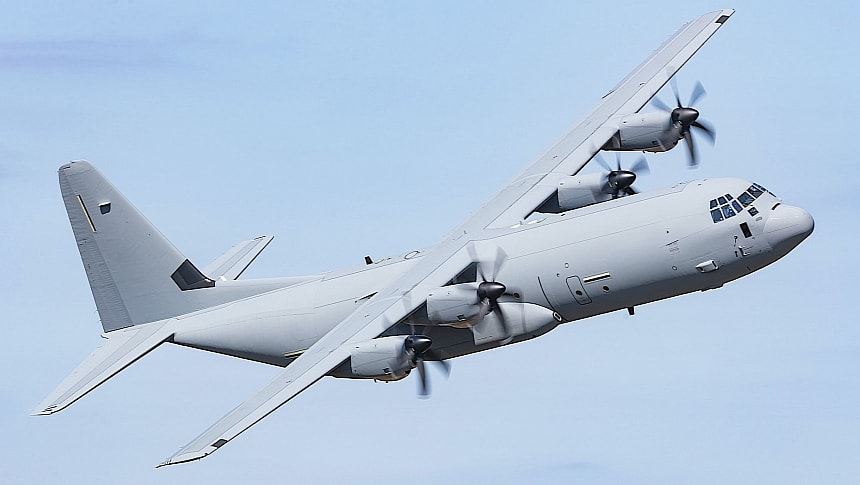One of the best ways to measure the success of an aircraft (or aircraft type) is to count the hours it stays in the air or the speed at which it reaches flight hours milestones. And when it comes to the fleet of C-130J Super Hercules, both metrics are pretty impressive.
The Super Hercules is, as the name says, the workhorse of the military aviation world. A derivation of the C-130 Hercules, it came about in the hangars of defense contractor Lockheed Martin in 1996, when it had its first flight, and entered operational service just three years later.
In the time that has passed since, the plane spread like wildfire, and it presently serves the needs of no less than 21 countries in some 18 different, mission-specific variants, including combat, transport, aerial refueling, medevac, search and rescue, and firefighting.
The global fleet of such airplanes counts a total of over 545 examples, and combined, they managed to reach a staggering three million flight hours mark.
If that's too big of a number to digest, think about it this way: these planes have flown together for the equivalent of 342 years. That's three centuries and a couple of decades short of a full human lifetime!
The accomplishment was announced by Lockheed Martin during the Farnborough International Airshow taking place in the UK. We're told the hours were logged from the plane's first flight 28 years ago and to the start of July 2024.
The total includes hours flown for tests and training, not only operational, but that doesn't diminish the accomplishment in the slightest. And to properly mark the moment, the defense contractor that makes the plane put together a nine-minute video showing the Super Hercules.
You can have a look at it below this text, but if you prefer a quicker way of getting to know the plane, here's the written rundown.
The C-130J Super Hercules is a four-engine turboprop (it uses Rolls-Royce engines capable of developing 4,700 horsepower each) with an impressive size: 112 feet (34 meters) from nose to tail and 132 feet (40 meters) from wingtip to wingtip. It can operate from runways or even dirt strips as long they allow the plane to speed on the ground for distances of up to 2,000 feet (610 meters).
The plane can lift 164,000 lbs (over 74 tons) of weight, meaning itself, plus a payload weighing as much as 46,700 lbs (21 tons). That's 30 percent more cargo than the aircraft it is based on. If used differently, it can also carry 44 percent more soldiers and 50 percent more Container Delivery System (CDS) bundles.
The cost of a single Super Hercules is not for the weak of heart. In 2017 fiscal year dollars the price tag reads $75,5 million per unit. The U.S. Air Force has 145 of them, the Air National Guard 181, and an extra 102 are part of the Air Force Reserve.
In the time that has passed since, the plane spread like wildfire, and it presently serves the needs of no less than 21 countries in some 18 different, mission-specific variants, including combat, transport, aerial refueling, medevac, search and rescue, and firefighting.
The global fleet of such airplanes counts a total of over 545 examples, and combined, they managed to reach a staggering three million flight hours mark.
If that's too big of a number to digest, think about it this way: these planes have flown together for the equivalent of 342 years. That's three centuries and a couple of decades short of a full human lifetime!
The accomplishment was announced by Lockheed Martin during the Farnborough International Airshow taking place in the UK. We're told the hours were logged from the plane's first flight 28 years ago and to the start of July 2024.
The total includes hours flown for tests and training, not only operational, but that doesn't diminish the accomplishment in the slightest. And to properly mark the moment, the defense contractor that makes the plane put together a nine-minute video showing the Super Hercules.
You can have a look at it below this text, but if you prefer a quicker way of getting to know the plane, here's the written rundown.
The C-130J Super Hercules is a four-engine turboprop (it uses Rolls-Royce engines capable of developing 4,700 horsepower each) with an impressive size: 112 feet (34 meters) from nose to tail and 132 feet (40 meters) from wingtip to wingtip. It can operate from runways or even dirt strips as long they allow the plane to speed on the ground for distances of up to 2,000 feet (610 meters).
The plane can lift 164,000 lbs (over 74 tons) of weight, meaning itself, plus a payload weighing as much as 46,700 lbs (21 tons). That's 30 percent more cargo than the aircraft it is based on. If used differently, it can also carry 44 percent more soldiers and 50 percent more Container Delivery System (CDS) bundles.
The cost of a single Super Hercules is not for the weak of heart. In 2017 fiscal year dollars the price tag reads $75,5 million per unit. The U.S. Air Force has 145 of them, the Air National Guard 181, and an extra 102 are part of the Air Force Reserve.














